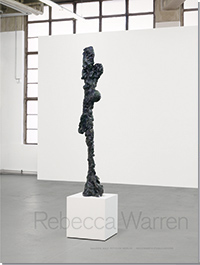Künstlerbücher / Special Editions
Almond, Darren / Blechen, Carl: Landschaften
Brown, Glenn: And Thus We Existed
Butzer, André: Exhibitions Galerie Max Hetzler 2003–2022
Chinese Painting from No Name to Abstraction: Collection Ralf Laier
Choi, Cody: Mr. Hard Mix Master. Noblesse Hybridige
Demester, Jérémy: Fire Walk With Me
Dienst, Rolf-Gunter: Frühe Bilder und Gouachen
Dupuy-Spencer, Celeste: Fire But the Clouds Never Hung So Low Before
Ecker, Bogomir: Man ist nie Alone
Elmgreen and Dragset: After Dark
Förg, Günther: Forty Drawings 1993
Förg, Günther: Werke in der Sammlung Friedrichs
Galerie Max Hetzler: Remember Everything
Galerie Max Hetzler: 1994–2003
Gréaud, Loris: Ladi Rogeurs Sir Loudrage Glorius Read
Grosse, Katharina: Spectrum without Traces
Hatoum, Mona (Kunstmuseum
St. Gallen)
Eric Hattan Works. Werke Œuvres 1979–2015
Hattan, Eric: Niemand ist mehr da
Herrera, Arturo: Boy and Dwarf
Hilliard, John: Accident and Design
Horn, Rebecca / Hayden Chisholm: Music for Rebecca Horn's installations
Huang Rui: Actual Space, Virtual Space
Kowski, Uwe: Gemälde und Aquarelle
Mikhailov, Boris: Temptation of Life
Mosebach, Martin / Rebecca Horn: Das Lamm
Neto, Ernesto: From Sebastian to Olivia
Oehlen, Albert: Spiegelbilder. Mirror Paintings 1982–1990
Oehlen, Albert: unverständliche braune Bilder
Oehlen, Pendleton, Pope.L, Sillman
Oehlen, Albert | Schnabel, Julian
Phillips, Richard: Early Works on Paper
Riley, Bridget: Gemälde und andere Arbeiten 1983–2010
Riley, Bridget: Die Streifenbilder 1961–2012
Riley, Bridget: Paintings 1984–2020
True Stories: A Show Related to an Era – The Eighties
Wang, Jiajia: Elegant, Circular, Timeless
Wool, Christopher: Westtexaspsychosculpture
Zhang Wei / Wang Luyan: Ein Gespräch mit Jia Wei

|
|
|||
Rebecca Warren Englisch |
Im Mittelpunkt des Buchs steht eine Werkgruppe handbemalter Bronzeskulpturen, die Rebecca Warren 2012 geschaffen hat. Mit ihren rauen Oberflächen erinnern die langgewachsenen Figuren ein wenig an Giacomettis existenzielle Arbeiten. Auf den zweiten Blick aber vervielfältigen sich die Bezüge, wie Jörg Heiser in seinem Essay schreibt, der unter anderem Referenzen an Daisy Duck, Sigmund Freud und Amy Winehouse entdeckt. Auch der Genderdiskurs spielt eine wichtige Rolleund reicht bis in die maskulin oder feminin konnotierten Materialien und Arbeitstechniken. Um den vielfältigen Aspekten und der Allansichtigkeit des Werks gerecht zu werden, sind die Skulpturen im Buch nebeneinander von allen vier Seiten abgebildet, so dass jeder in die Form geknetete Fingerabdruck, jede farbliche Nuance der Bemalung im Detail sichtbar wird. Ein Triptychon von Vitrinenarbeiten mit Materialien aus dem Atelier der Künstlerin sowie einige Würfelskulpturen aus ungebranntem Ton, die wie leere, brüchige Sockel erscheinen, runden die Werkauswahl ab.
BRONZE HEADS AND HAIR BOWS Rebecca Warren’s recent series of seven sculptures are like stalagmites built not from minerals and salt, but from a plethora of archetypes, clichés and inventions, both ancient and contemporary, shaped into perplexing new form by the artist’s hands. They have been sculpted in clay around a metal armature, then cast in bronze and hand-painted with car veneer to appear reminiscent of glazed ceramics. Roughly human-sized, their outline is slender and commanding at first (as well as a stalagmite, you might also think of a magnified tin soldier), yet some elements stick out like sore thumbs, or rather like bent elbows or bulbous noses or, in fact, like singular silicon breasts. The sculptures are placed on plinths, each coloured a different pastel hue, that are (purposefully and awkwardly) a little too modest and small to fulfil the plinth’s classical role as guarantor of distinction and authority. Meanwhile, the sculptures themselves have undulating surfaces that feel at once amorphous (like the skin of a thickly magmatic brew) and haptic (shaped by the artist’s hands, with imprints of the fingers’ tips and the hand’s gripping palm). With these qualities of shape and material all combined, these works make me think not only of stalagmites and tin soldiers, but also of Alberto Giacometti, Etruscan statues, Daisy Duck and Minnie Mouse, Giuseppe Arcimboldo, Sigmund Freud, Johann Wolfgang von Goethe, Amy Winehouse, Marisa Merz, Auguste Rodin and Medardo Rosso ... Take, for example, Toto (2012), one of the seven slender sculptures. Apart from a large triangular element, reminiscent of Giacometti-esque sideways-pointing breasts, a big bulbous nose or a bent elbow, protruding from what could thus be read as the torso of the figure, there is also a hair bow stuck prominently on top of its (narrow, heavily contorted) ‘head’. While the rest of the bronze is covered in hues of terracotta and cyan, the hair bow is blotched in old rose and pistachio, emphasizing the composite rather than unified aspect of the piece. The hair bow is a returning motif in Warren’s work (see, for example, the voluptuous clay female figure Pony from 2003, which features a hair bow on top of its head like a boudoir pillow). It is a perfect shorthand code for cartoon female role models courtesy of Disney. Both Daisy Duck and Minnie Mouse sport huge hair bows that strongly differentiate them from their male hero counterparts Donald and Mickey. Warren pits these simplified cartoonist patterns of gender against the equally simplified, but pronouncedly ‘serious’ patterns that the male-dominated history of modernism has to offer. This experimental, slapstick collision of Giacometti and Disney, literally cast or pressed into one physical body, leaves neither unharmed. In fact Warren’s sculpture could be read as a response to culturally entrenched gender tropes – the slender modernist outline on the one hand, and the Disneyish codification of cuteness and effervescence on the other hand – colliding in the real world, in real people’s lives. Think of the late Amy Winehouse: big breast implants and anorexia; Warren does not merely make illustrative comments by pitting two things against each other, however. There is more at play. Sticking two things together that ‘don’t fit’ is just one possible method. Another is to duplicate (while twisting the logic of duplication); another, to alter proportion (elongate, squeeze etc.). And yet another is to use materials and conventions in unconventional ways. Think of Winehouse again: the postmodern mixture of visual styles and the clear modernism of Soul music.
... In Zusammenarbeit mit Galerie Max Hetzler, Berlin
|